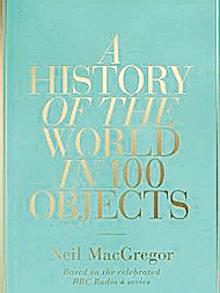I’m liking
I didn’t know quite how much I didn’t know before Neil MacGregor started showing me around the world.
My favourite podcasts last year came from a surprising collaboration between BBC Radio 4 and the British Museum. The task they set themselves was to tell the story of human civilisation using 100 objects from the Museum’s collection. Given the visual and tactile nature of, well, objects, it was a brave and clever choice to tell this history on radio, demanding that listeners use their imaginations (or their internet connections) to participate in the examination of the objects and their significance.
This book is the transcript of those radio shows, which you may also have heard on Radio New Zealand National on Sunday afternoons in 2011. Here they are accompanied by gorgeous colour photographs of the objects.
History is written by the victors, especially if they are the only ones who can write. As Museum director and author MacGregor writes, most of the world, for most of history, has been illiterate, so a history told from written sources can never hope to tell everyone’s stories. Societies without texts can, however, tell their stories across the centuries through the objects they created.
What kind of objects? A two million-year-old stone chopping tool used by our African ancestors; a saucy sculpture of a couple entwined, made nine thousand years ago; a relief revealing that the Mayan queen underwent a torturous sacrificial act (there are tongues, thorns and blood involved) to ensure her husband’s success. MacGregor writes: ‘Sado-masochism, on the whole, receives a bad press.’
The objects were chosen to tell lots of stories at once. The Rosetta Stone is primarily significant because its message is written in three languages, helping archaeologists to break the code of hieroglyphics. But since Great Britain and Napoleon’s France fought over possession of it, in MacGregor’s hands it also tells a story of European war and politics in another age. All the Objects have this kind of kaleidoscopic significance, so a little way through the book, you can see the possibility of circumnavigating the globe, in time and space, in just 100 pieces of stuff.
Extra for Experts
Most of us know the optimistic agony of watching a movie adaptation of a book we love. The 100 Objects have made rather a smoother transition to print, of course, since the radio programmes are essentially transcribed, and now come with the bonus of pictures.
One of the cool things about the radio programme, though, was hearing the voices of experts from right around the world chipping in their insights. In the book, they still speak, but all in the same font. I felt lucky to be reading the book as an accompaniment to the audio and would recommend checking out the website and podcast options to round the experience out.
Readers without those frills are still well served by the conversational style and snappy chapters. This isn’t a difficult, worthy tome, but an engaging survey of humanity’s oddities and achievements over two million years.
Conclusion
The British Museum is one of my favourite places in London. This fantastic book, substantial and easy at the same time, is a window into the astonishing depth and breadth of the Museum’s collection, a substitute for those unable to visit and bait for those who can.


